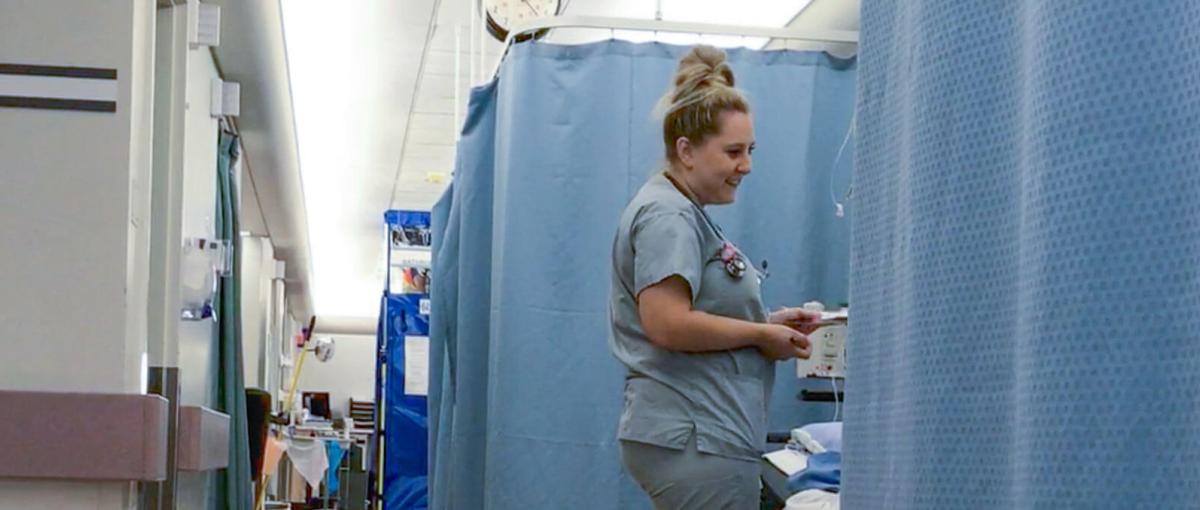Holistic care in emergency
Seniors get connected to community supports through ED visits

May 3, 2020
By Brenton Driedger, Social Media and Storytelling Advisor, Covenant Health
An elderly woman is brought to the Misericordia Community Hospital emergency department. After months of gradual decline from an undiagnosed cognitive impairment, the woman’s loss of functioning has progressed significantly in recent weeks, putting extra strain on her daughter and son-in-law, whom she lives with.
Nurse practitioner Jamie Mergaert assesses the woman, refers her to a geriatric outpatient clinic and gets her started on medication to slow the progression of her dementia. A transition coordinator sets her up with home care and connects her to the First Link early intervention program at the Alzheimer’s Society. They also refer her to a day program to give her family one day a week of respite. The combination of medical, social and community supports enables the woman to return home.
“She’s able to continue living in her home, and her family is able to care give for her but not feel as burned out,” says Jamie.
This story is a common one in an emergency department (ED). Patients come to the hospital for a wide range of concerns. They might be suffering from an acute condition and need to be admitted. Or they might come to the ED instead of going to their family physician.
“When older adults aren’t feeling well, when families find that they’re doing a lot of caregiving and they see changes in their loved one, they don’t always know what to do with that information,” says Bonnie Launhardt, program manager for medicine and geriatrics at the Misericordia. “They don’t always know where to go.”
After people are treated and assessed in emergency, a gap can appear. Patients have their acute needs met and return home without additional support or follow-up. In 2013, the Misericordia started a Geriatric Evaluation and Management in the ED program (GEM-ED) to identify older adults who come to emergency with unmet geriatric needs and to make sure community supports are in place when they’re discharged.
When a patient comes in, they’re assessed by a physician and triage nurse. If they think the patient needs more support beyond their presenting concern, they book a consult at the geriatric outpatient clinic or invite the physician or nurse practitioner from the GEM-ED team to see them. Their consult looks at whether the patient has multiple geriatric conditions, such as recurrent falls, bowel or bladder problems, increasing weakness or frailty, and considers a variety of ways to follow up.
- Read more: ER support program for seniors flourishing
The GEM-ED’s approach was informed by a two-year evaluation project funded by the Network of Excellence in Seniors’ Health and Wellness. The average age of the 300 GEM-ED patients included in the evaluation was 84 years old. Three-quarters of them lived at home, and half of them did not have home care.
Dr. Anjali Sarker, a geriatric physician who splits her time between the emergency department and the geriatric outpatient clinic, says the ED is an effective place to make sure older patients are not falling between the cracks.
“It’s becoming more and more known to everyone that the emergency department is an area where there’s such a large volume and that it’s a great place to target and find these high-risk patients,” she says.
“It is a good place to start putting in those resources as appropriate.”
Anjali remembers a patient who made half a dozen emergency visits, all for general issues like abdominal pain. Each time, physicians found no medical concerns. But this time, they referred her to the geriatric outpatient clinic.
“We picked up that she had a lot of anxiety and ended up starting her on some medications and providing some resources for that,” says Anjali. “I saw her in follow-up a few months later, and she hadn’t gone back to emerg since we’d seen her.”
That’s a common experience. The GEM-ED survey found that 86 per cent of patients felt the care they got in emergency met their needs and that 82 per cent followed up on at least one of the referrals made by the GEM-ED team. And there’s been a significant reduction in readmission rates for 31 to 90 days after the intervention.
The GEM-ED team sees more than 1,000 patients a year. Some patients are admitted, but most of them can return home with some added support like Meals on Wheels, home care or a referral to their family doctor to follow up or review their medications.
“We’re not saying that they need to take these services because they’re failing. It’s ‘Here are these services to help you stay independent because we want you to be independent. We want you to be successful. We want you to be happy in your community,’” says Bonnie.
The program also eases the burden on caregivers. Anjali and Jamie stagger their hours so one of them is available in the late afternoon and early evening, when children often visit their aging parents and decide they need to get them to emergency. And those caregivers benefit from having time and space to feel all their concerns are heard.
“Most of the people we see are quite appreciative to be able to tell their stories and to tell these issues,” says Anjali. “Often, I find that a lot of the caregivers are also strained and burdened, so I think they appreciate the opportunity to give background.”
Jamie says GEM-ED enables them to help patients and support their caregivers by looking at more than just the acute medical reason they came for.
“Say they had a fall, but why did they have that fall? We kind of dig deeper and look at all these layers,” says Jamie. “We’re looking at it from a more holistic geriatric viewpoint.”